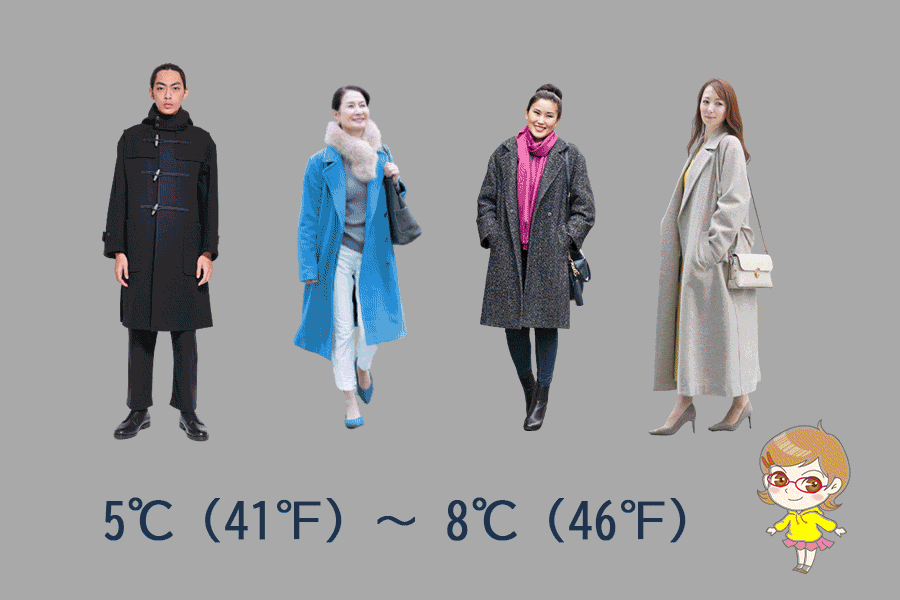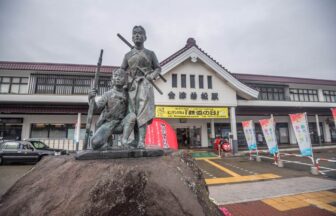7 Chome-1-3 Fukushima, Fukushima Ward, Osaka, 553-0003 MAP
↓ Click to jump to the relevant section.
| Current Weather | Annual Weather | Tourist Attractions |
| Baggage Deposit | Hotels |
Current weather and clothing

The weather information shown here is the information closest to the station in question. Please note that there may be slight differences.
Yearly temperature changes and recommended clothing
Clothing recommendations for each temperature range
When traveling in Japan with the following average temperatures, the recommended clothing is as follows:
Monthly changes in temperature, precipitation, and snowfall (1991~2020 average, Japan Meteorological Agency survey)
| Jan. | Feb. | Mar. | Apr. | May | Jun. | Jul. | Aug. | Sep. | Oct. | Nov. | Dec. | |
| temperature(°C) | 1.9 | 2.5 | 5.9 | 11.7 | 17.2 | 20.7 | 24.3 | 25.5 | 21.6 | 15.6 | 9.5 | 4.3 |
| precipitation(mm) | 56.2 | 41.1 | 75.7 | 81.8 | 88.5 | 121.2 | 177.7 | 151.3 | 167.6 | 138.7 | 58.4 | 48.9 |
| snowfall(cm) | 49 | 34 | 14 | 1 | — | — | — | — | — | — | 1 | 24 |
Winter
December
The average temperature in December is 4.3°C. The region experiences frequent snowfall in December, with an average of 24 cm of snow. Visitors are advised to pack warm clothing such as heavy coats, thick sweaters, gloves, hats, and scarves. It is also recommended that visitors pack thermal underwear, warm leggings or stockings, and waterproof boots with good traction to navigate the snow-covered roads. Layers of clothing will help to keep warm in the cold outdoors and regulate body temperature indoors.
January
The weather in JR Fukushima Station is cold and snowy during January. The average temperature is 1.9°C, and the precipitation is 56.2mm. For men and women who plan to visit the station, it is recommended that they wear thick coats, sweaters, warm pants, and boots to keep warm. Additionally, a scarf, hat, and gloves are essential to protect the face and hands from the cold.
February
In February, the temperature at JR Fukushima Station is still quite cold, with an average temperature of 2.5°C. The precipitation is less than in January, with an average of 41.1mm. Visitors to the station should still wear warm clothing such as a coat, sweater, and thick pants, along with boots to keep feet warm. Gloves, hats, and scarves are still necessary to protect against the cold weather.
Spring
March
During March, the weather at JR Fukushima Station starts to warm up. The average temperature is 5.9°C, and the precipitation is 75.7mm. Visitors should wear lighter clothes such as a light coat, sweaters, and a light scarf. Women can wear skirts, but make sure to wear tights or leggings underneath for extra warmth. Men should wear trousers, a sweater, and a coat to keep warm.
April
In April, the weather at JR Fukushima Station is mild with an average temperature of 11.7°C. The precipitation is 81.8mm. A lightweight jacket or sweater with a pair of jeans or trousers are sufficient for men and women visiting the station. It’s also advisable to carry an umbrella or a raincoat to prepare for the rain.
May
The weather in May at JR Fukushima Station is pleasant with an average temperature of 17.2°C. The precipitation is 88.5mm. It is an ideal month to wear lighter clothing, including t-shirts, light trousers, and skirts for women. Men can wear shorts or jeans with a t-shirt or light sweater. Since the rain is still possible in May, it’s a good idea to carry an umbrella.
Summer
June
The weather at JR Fukushima Station is warm and humid during June with an average temperature of 20.7°C. The precipitation is 121.2mm. Lightweight and breathable clothes, such as cotton or linen shirts, are recommended for men and women. Shorts, skirts, or light trousers are suitable for both sexes. Visitors should bring an umbrella or a raincoat because there are chances of rain.
July
July is the hottest month of the year in JR Fukushima Station, with an average temperature of 24.3°C. The precipitation is 177.7mm. Women can wear sleeveless dresses or skirts, whereas men can wear t-shirts and shorts to keep cool. It’s essential to carry a sunhat or umbrella to protect against the sun.
August
The temperature in August remains hot, with an average temperature of 25.5°C. The precipitation is 151.3mm. Similar to July, men and women can wear light clothes such as shorts, t-shirts, skirts, and dresses. Lightweight and comfortable shoes are essential to prevent overheating. It’s also recommended to bring an umbrella or a hat to shield against the sun.
Autumn
September
In September, the temperature starts to cool down with an average temperature of 21.6°C. The precipitation is 167.6mm. Men and women should bring light jackets or sweaters, particularly for evenings as the temperature gets lower. Women can wear skirts, while men can wear trousers. It’s still necessary to carry an umbrella for the occasional rain.
October
The month of October marks the beginning of autumn, and temperatures continue to drop from the warm summer temperatures of September. The average temperature in October is 15.6°C. During the daytime, temperatures can reach as high as 20°C, but they often drop below 10°C at night. The weather is generally pleasant, with clear skies and comfortable humidity levels. However, there is a possibility of occasional rain, and the average precipitation is 138.7 mm. Therefore, visitors are advised to pack clothes suitable for both warm and cool weather. Clothing for men and women should include a mix of long-sleeved shirts, light jackets or sweaters, and trousers.
November
November marks the beginning of winter in Japan, and temperatures continue to drop steadily from October. The average temperature in November is 9.5°C. The temperature at night can drop to freezing levels, and there is a possibility of occasional snowfall. The average precipitation in November is 58.4 mm. Visitors are advised to pack warm clothing such as thick coats, sweaters, gloves, hats, and scarves. Clothing for women should also include warm stockings or leggings, while men should pack thermal underwear. Waterproof boots with good traction are necessary to navigate the potentially icy roads. It is essential to dress in layers to keep warm in the cold outdoors and regulate body temperature indoors, where it can be warm.
Recommended tourist destinations
Aquamarine Fukushima
50 Tatsumicho, Onahama, Iwaki 971-8101 Fukushima Prefecture
Exhibits include bonito, sardines, and other sea creatures that live off the coast of Fukushima. Visitors can also enjoy a touch pool where they can directly touch the sea creatures and try their hand at fishing.
Hanamiyama Park
17 Hara Watari, Fukushima 960-8141 Fukushima Prefecture
Fukushima’s most famous flower spot. In spring, about 70 kinds of flowers such as cherry, cherry blossom, plum, and magnolia bloom at different times of the year. The park has a tour course that can be completed in 30 or 60 minutes.
Abukumado Limestone Cave
1 Takinemachisugaya, Tamura 963-3601 Fukushima Prefecture
The limestone cave is approximately 600 meters long. The stalactites are illuminated to create a fantastic atmosphere. In addition to the general tour course, there is also an exploration course to make visitors feel like they are on an adventure.
Tsuruga jo Castle
1-1 Otemachi, Aizuwakamatsu 965-0873 Fukushima Prefecture
One of the most famous castles in Japan, built about 630 years ago, the castle was rebuilt in 1965 and the interior is now a museum. The top floor of the castle commands a panoramic view of the city of Aizu Wakamatsu.
Goshikinuma Lake
Hibara, Kitashiobara-mura, Yama-gun 969-2701 Fukushima Prefecture
There are 30 colorful lakes and marshes of various sizes created by the eruption of Mt Bandai. Each swamp has its own color, such as cobalt blue and emerald green. There is a well-maintained promenade, which is crowded with tourists who enjoy strolling through the lakes.
Aizu Old Samurai Residences
1 Higashiyamamachi Ishiyama, Aizuwakamatsu 965-0813 Fukushima Prefecture
This large-scale historical museum park is a restored samurai residence of a feudal lord of the Aizu domain. There is also a diorama of samurai dolls reproducing historical scenes, allowing visitors to learn about life in those days.
Sazaedo
Ikkimachiyahata, Aizuwakamatsu 965-0003 Fukushima Prefecture
The three-story hexagonal Kannon Hall was built in 1796. There are no stairs inside, but rather a double spiral passageway, providing a magical experience in which ascending and descending visitors never pass each other.
Suehiro Sake Brewery
12-38 Nisshincho, Aizuwakamatsu 965-0861 Fukushima Prefecture
A long-established sake brewery established in 1850. The historic building is designated as a cultural asset and can be toured. The café offers chiffon cakes and other treats made with sake.
Where to leave your luggage
Fukushima Station has coin lockers located at both the West and East Exits.
Coin lockers at Fukushima Station are available from 5:30 to 23:20.
1) West Exit: You can find them by going through the West Exit ticket gate and proceeding toward the stairs. You can also find them on the first floor of the West Exit.
2) East Exit: Located near the east exit. There are also coin lockers located near the ATM at the bottom of the stairs on the first floor.
Recommended hotels and inns
Richmond Hotel Fukushimaekimae
1-15 Mikawaminamimachi, Fukushima 960-8053 Fukushima Prefecture
2-minutes walk from Sendai Station
Hotel class: 3
Hotel style: Family , Charming
Check Rates & Availability:
>> See on Tripadvisor
>> See on Trip.com
>> See on Expedia
The Celecton Fukushima
13-73 Otacho, Fukushima 960-8068 Fukushima Prefecture
1-minute walk from Fukushima Station
Hotel class: 3.5
Hotel style: Business
Check Rates & Availability:
>> See on Tripadvisor
>> See on Trip.com
>> See on Expedia
Hotel Sankyo Fukushima
7-11 Omachi, Fukushima 960-8041 Fukushima Prefecture
11-minutes walk from Fukushima Station
Hotel class: 3
Hotel style: Business
Check Rates & Availability:
>> See on Tripadvisor
>> See on Trip.com
>> See on Expedia
JR-East Hotel Mets Fukushima
1-1 Sakae-machi, Fukushima 960-8031 Fukushima Prefecture
4-minutes walk from Fukushima Station
Hotel class: 3
Hotel style: Business
Check Rates & Availability:
>> See on Tripadvisor
>> See on Trip.com
>> See on Expedia
Hotel Sunroute Fukushima
2-6 Nakamachi, Fukushima 960-8043 Fukushima Prefecture
9-minutes walk from Fukushima Station
Hotel class: 3
Hotel style: Business
Check Rates & Availability:
>> See on Tripadvisor
>> See on Trip.com
Onyado Kawasemi
2-14 Hisuinosato Iizakaonsen, Fukushima 960-0201 Fukushima Prefecture
4.7 mi/7.6 km from Fukushima Station
Hotel class: 4
Hotel style: Romantic , Great View
Check Rates & Availability:
>> See on Tripadvisor
>> See on Trip.com
GrandPark Hotel Excel Fukushima Ebisu
10-6 Sonedacho, Fukushima 960-8051 Fukushima Prefecture
6-minutes walk from Fukushima Station
Hotel class: 3
Hotel style: Centrally Located , Family
Check Rates & Availability:
>> See on Tripadvisor
>> See on Expedia
APA Hotel Fukushima Ekimae
8-20 Otamachi, Fukushima 960-8068 Fukushima Prefecture
2-minutes walk from Fukushima Station
Hotel class: 3
Hotel style: Business
Check Rates & Availability:
>> See on Tripadvisor
>> See on Expedia
Hotel Crown Hills Fukushima
11-25 Sakaemachi, Fukushima 960-8031 Fukushima Prefecture
7-minutes walk from Fukushima Station
Hotel class: 3
Hotel style: Business
Check Rates & Availability:
>> See on Tripadvisor
>> See on Expedia
We support your itinerary planning!
Click the button to get an overview of hotel information and popular tourist routes from all over Japan featured on our site. We’ve included comprehensive details to aid in planning your trip, so please make use of it.
Comprehensive checklist before traveling to Japan

Book flights
Compare and purchase flight tickets
When planning your trip to Japan, it's advisable to start by researching flights several months in advance. Airlines often release promotional fares, especially during off-peak seasons. Use comparison sites like Skyscanner or KAYAK to get a sense of the price range. Be flexible with your travel dates if possible; flying mid-week might be cheaper than on weekends.
>> Visit Skyscanner's official website
>> Visit KAYAK's official website
Order Japan Rail Passes for each family member
Purchase your Japan Rail Pass before departure
The Japan Rail (JR) Pass offers unlimited travel on JR trains, making it a cost-effective option for tourists. However, it's only available to foreign tourists and must be purchased *before* you arrive in Japan. Determine the areas you plan to visit; if you're traveling extensively, a nationwide pass is beneficial, but if you're only exploring a specific region, consider regional JR passes. Children under 12 get a discounted pass, so ensure you order the correct type for each family member.
>>Visit Japan Rail Pass's website
Plan your attire for Japan
Check the weather at your destination on this site
Japanese weather varies significantly by season. In summer, it's hot and humid, so breathable clothes are essential. Winters, especially in the north, can be cold, requiring warm attire. If visiting during the rainy season (June to early July), pack a good umbrella and waterproof shoes. While Japan is generally casual, certain places like temples, shrines, or upscale restaurants may require modest and neat dressing.
Reserve a pocket Wi-Fi or SIM card

SIM card or pocket Wi-Fi is required
Beyond clothes, consider packing essentials like a universal power adapter (Japan uses Type A and B sockets), portable Wi-Fi or SIM card for internet access, and any necessary medications (with a copy of the prescription).
Which is better: a SIM card or pocket Wi-Fi?
When traveling in Japan, one essential to consider is securing internet access, especially given that many locations still don't offer free Wi-Fi. To ensure you can use your smartphone throughout your trip, you'll typically have three options: (1) a SIM card, (2) pocket Wi-Fi, or (3) the roaming service provided by your mobile company. Roaming services can be quite expensive, so we often recommend using a SIM card or pocket Wi-Fi. While SIM cards tend to be more affordable than pocket Wi-Fi, they can be trickier to set up. Pocket Wi-Fi, on the other hand, can be shared among several users, making it a favorable choice for families or groups.
▼SIM card
Advantages:
Relatively affordable.
Disadvantages:
Can be time-consuming to set up initially.
May have strict data limits.
▼Pocket Wi-Fi
Advantages:
Offers substantial data allowances.
A single device can be shared among multiple users.
Easily usable with PCs as well.
Disadvantages:
Typically more expensive.
Japan's representative services

Sakura Mobile's website
▼SIM card
>>Visit Sakura Mobile's official website
>>Visit mobal's official website
▼pocket Wi-Fi
>>Visit Sakura Mobile's official website
>>Visit NINJA WiFi's official website
>>Visit Wi-Fi RENTAL Store's official website
Book local tours as needed
Pre-book your tour and have a great trip!
Local tours offer deep insights into Japan's culture and heritage. Websites like Viator or GetYourGuide offer a variety of tours, from traditional tea ceremonies to modern pop culture tours in Akihabara. Consider unique experiences like staying with monks on Mt. Koya or taking a cooking class to learn authentic Japanese dishes.
>>Visit Viator's official website
>>Visit GetYourGuide's official website
Purchase advance tickets for popular attractions
Make a reservation to avoid crowds
Attractions like Tokyo Disneyland, Universal Studios Japan, or the Studio Ghibli Museum often have long ticket queues. Buy tickets online in advance to save time. Some attractions also have timed entry, so check the specific time slots available and plan accordingly.
▼Tokyo Disney Resort
>>Visit Tokyo Disney Resort official website
>>Visit Viator's Tokyo Disneyland page
>>Visit Viator's Tokyo DisneySea page
>>Visit GetYourGuide's Tokyo Disneyland page
>>Visit GetYourGuide's Tokyo DisneySea page
▼Universal Studios Japan
>>Visit USJ official website
>>Visit Viator's USJ page
>>Visit GetYourGuide's USJ page
Buy travel insurance

insurance concept, health, life and travel insurance
It is important to be prepared for emergencies
While Japan is a safe country, travel insurance is crucial for unforeseen events like health emergencies, travel disruptions, or lost baggage. Ensure your policy covers medical expenses in Japan, as healthcare, though excellent, can be expensive.
Here we introduce online travel insurance services that are popular worldwide.
World Nomads: An online travel insurance service widely endorsed by travelers worldwide. They offer plans that cover adventurous activities and high-risk sports.
>>Visit World Nomads' official website
AIG Travel Guard: An insurance service available to travelers all over the world. They offer a wide range of options, including cancellation protection and emergency medical insurance.
>>Visit AIG Travel Guard's official website
Share your itinerary with emergency contacts
Organize your reservation information
Keep a digital and printed copy of your detailed itinerary, including hotel addresses, train schedules, and booked tours. Share this with a trusted family member or friend not traveling with you.
















